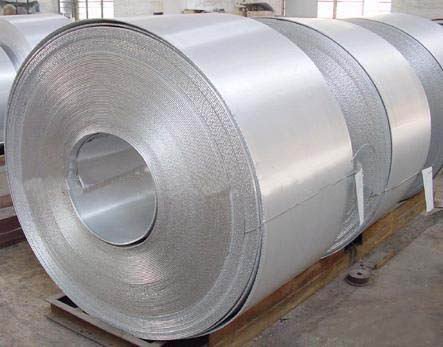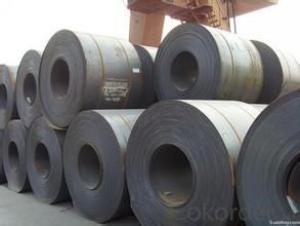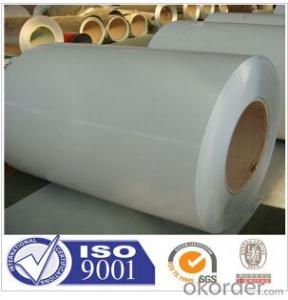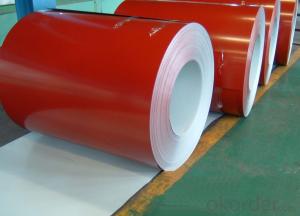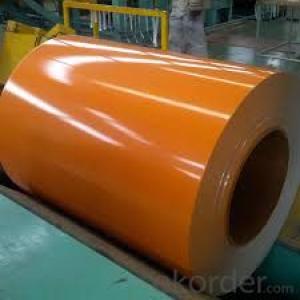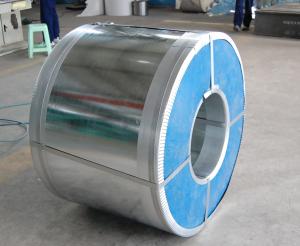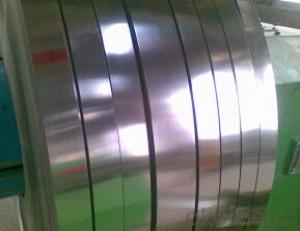galvalume steel coil with high quality e GL AZ60G-275G Anit-finger or oiled surface
- Loading Port:
- China Main Port
- Payment Terms:
- TT OR LC
- Min Order Qty:
- -
- Supply Capability:
- -
OKorder Service Pledge
Quality Product, Order Online Tracking, Timely Delivery
OKorder Financial Service
Credit Rating, Credit Services, Credit Purchasing
You Might Also Like
Packaging & Delivery
| Packaging Detail: | seaworthy packing |
| Delivery Detail: | 20~40 days after receiving desposit |
Specifications
galvalume coil with high quality
Thickness:0.3-2.5mm
Width:914-1250mm
AZ50~AZ150
galvalume coil with high quality
(1). Quality Standard: ASTM A792 CS-B SGLCC JIS G3321
(2). Thickness: 0.3-2.5mm
(3). Width: 914-1250mm
(4)Coil ID:508mm/610mm
(5). Coil Weight: 3~15MT
(6)Aluminium zinc layer:AZ50~AZ150G/M²
(7)Surface treatment:passivation treatment,oiling,anti-fingerprint treatment
(8)Packaging:seaworthy packing
- Q: What is the maximum width of galvanized steel strip, please? The galvanized coat is 275, and how long is one coil?
- But this kind of steel coil is not well processed in the market. At the beginning of Wuhan, several processing plants are good at processing, and other processing plants usually process 1850 at most.
- Q: What are the different methods of tempering steel coils?
- There are several methods of tempering steel coils, including air tempering, oil tempering, salt bath tempering, and induction tempering. Each method involves heating the steel coils to a specific temperature and then allowing them to cool slowly to achieve the desired level of hardness and toughness. Air tempering involves exposing the steel coils to ambient air for gradual cooling, while oil tempering involves immersing them in heated oil. Salt bath tempering involves placing the coils in a bath of molten salt, and induction tempering uses electromagnetic induction to heat the coils. The choice of tempering method depends on the specific requirements of the steel and the desired properties of the final product.
- Q: What are the common defects found in steel coils?
- Some common defects found in steel coils include surface defects like scratches, indentations, and pits, as well as internal defects such as cracks, lamination, and segregation. Other defects can include edge wave, coil breaks, and coil set.
- Q: What are the common methods of protecting steel coils from corrosion during storage?
- Common methods of protecting steel coils from corrosion during storage include applying a protective coating or film, using desiccants or moisture-absorbing materials, implementing proper ventilation and climate control, employing corrosion inhibitors or VCI (Vapor Corrosion Inhibitors), and ensuring adequate packaging and sealing to prevent exposure to moisture or contaminants.
- Q: Are steel coils recyclable?
- Yes, steel coils are recyclable. Steel is a highly recyclable material that can be melted down and used to create new steel products, including steel coils. Recycling steel coils helps to conserve natural resources, reduce energy consumption, and minimize waste.
- Q: Can steel coils be stored in unheated warehouses?
- Yes, steel coils can be stored in unheated warehouses. Steel coils are not typically affected by low temperatures, as they are durable and resistant to cold weather conditions. However, it is important to ensure that the warehouse is dry and free from moisture, as prolonged exposure to dampness can cause rust and corrosion on the steel coils.
- Q: What are the environmental impacts of steel coil production?
- The environmental impacts of steel coil production include emissions of greenhouse gases, such as carbon dioxide, during the process of extracting and processing raw materials like iron ore and coal. Additionally, the production of steel coils requires a significant amount of energy, contributing to the depletion of natural resources and increased carbon emissions. The wastewater generated during steel production can also contain pollutants, which may harm aquatic ecosystems if not properly treated. Furthermore, the disposal of steel coil waste, such as slag and other by-products, can pose challenges in terms of proper handling and potential contamination of soil and water sources. Overall, steel coil production has substantial environmental impacts that demand sustainable practices and mitigation measures.
- Q: How do steel coils contribute to energy efficiency?
- Steel coils contribute to energy efficiency in several ways. Firstly, steel coils are lightweight and can be easily transported, reducing the energy consumption associated with transportation. Additionally, steel coils have high heat transfer properties, allowing for more efficient heat exchange in various applications such as HVAC systems. Moreover, steel coils are durable and long-lasting, reducing the need for frequent replacements and saving energy associated with manufacturing new coils. Lastly, steel coils can be recycled, reducing the energy consumption and environmental impact of producing new steel. Overall, the use of steel coils promotes energy efficiency by reducing energy consumption, improving heat transfer, and facilitating recycling.
- Q: What are the cost considerations when purchasing steel coils?
- When purchasing steel coils, there are several cost considerations that need to be taken into account. Firstly, the price per unit of steel coil is a significant factor. The cost of steel coils can vary depending on various factors such as the type of steel, its grade, thickness, width, and length. Higher-grade steel coils tend to be more expensive than lower-grade ones, and thicker or wider coils can also come at a higher cost. Another cost consideration is the quantity of steel coils needed. Purchasing larger quantities of steel coils often comes with volume discounts, so it is important to determine the required quantity and assess whether it is more cost-effective to buy in bulk or in smaller batches based on the demand and storage capacity. Transportation costs should also be considered when purchasing steel coils. The weight and size of the coils can impact the shipping costs, especially if they need to be transported over long distances. Additionally, the distance between the supplier and the buyer can affect freight charges, so it is crucial to evaluate different shipping options and choose the most cost-effective method. Furthermore, it is essential to take into account any additional costs associated with processing or customizing the steel coils. For instance, if the coils need to be cut, leveled, or coated, these additional services can add to the overall cost. It is important to obtain quotes from different suppliers and compare the prices for these value-added services. Lastly, it is crucial to consider the overall quality and reliability of the steel coils. While cheaper options may initially seem more cost-effective, they could end up costing more in the long run if they do not meet the required standards or have a shorter lifespan. It is advisable to choose reputable suppliers with a track record of delivering high-quality products to ensure that the investment in steel coils is worthwhile. In conclusion, the cost considerations when purchasing steel coils include the price per unit, quantity discounts, transportation costs, additional processing services, and the overall quality and reliability of the coils. Evaluating these factors thoroughly will help make an informed decision that balances cost-effectiveness with the desired quality and specifications of the steel coils.
- Q: where can you find carbon steel in los angeles?? what store?? preferabbly 01 carbon steel
- All steel has carbon in it, usually less than 1%. The fancy steels that have enough other elements mixed in are generally called alloy steels. So, carbon steel usually refers to the most basic cheap steel. A36 is a kind of carbon steel that meets specific standards of the A36 specification. I don't know what 01 carbon steel is. Steel is available all over Los Angeles so just look in the phone book yellow pages under steel or metal. If you are near El Monte, my favorite place is Industrial Pipe and Steel, lots of cheap scrap, used machinery, and a huge industrial hardware store built right in. There is a place in Gardena called MK Metals. There's a great place just north of the Burbank airport (can't remember the name) and one in Harbor City called Action Metals (big on recycling). No sense driving all over. Just check the phone book. Two very common carbon steels just go by the terms hot rolled and cold rolled. Hot rolled is the cheapest and softest and still has the mill scale attached so the surface is a little rough and uneven, but this is by far the most commonly used. Cold rolled (usually the AISI 1018 grade) has been work hardened and rolled flat and smooth. It's slightly more expensive but stronger and prettier. If you are going to cut away some of the thickness and you want the steel to remain flat, you probably want hot rolled steel because sometimes the cold rolled steel (CRS) will warp. It does that because the steel is already prestressed from the cold rolling process and when you cut away some of the pre-stressed material the forces holding the material flat are no longer balanced.
Send your message to us
galvalume steel coil with high quality e GL AZ60G-275G Anit-finger or oiled surface
- Loading Port:
- China Main Port
- Payment Terms:
- TT OR LC
- Min Order Qty:
- -
- Supply Capability:
- -
OKorder Service Pledge
Quality Product, Order Online Tracking, Timely Delivery
OKorder Financial Service
Credit Rating, Credit Services, Credit Purchasing
Similar products
Hot products
Hot Searches
Related keywords



